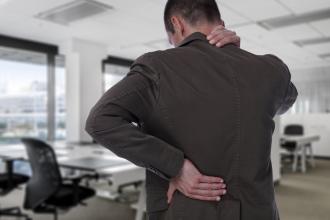Discussing low back pain and medical imaging with your patients
Low back pain is a clinical condition that is frequently not well explained by medical imaging or other diagnostic testing, yet many patients have a high expectation of receiving a precise diagnosis from such tests.
In our experience, many patients are confused about the meaning of their medical imaging reports and some even think that early degenerative changes mean that they should worry about continuing with normal levels of physical activity.
Most physicians are familiar with the many medical guidelines for the investigation of low back pain. The WorkSafeBC clinical guidelines for the diagnosis and treatment of low back pain can be viewed online at www.worksafebc.com/health_care_providers/Assets/PDF/pracguide_backpain.pdf.
Acutely, the priority is to rule out more serious conditions such as fractures, infections, or tumors, and community physicians often initially investigate patients with back pain without the involvement of WorkSafeBC.
Call us anytime
Once a claim has been accepted, investigations (including X-rays and specialist consultations) can be ordered without WorkSafeBC approval, but medical advisors are available to discuss medical claim issues with any community physician. Medical advisors can also assist with expediting CT/MRI examinations. (Either indicate on the F11 that you would like a medical advisor to call you, or call 1 888 967-5377 and ask to speak to a medical advisor.)
Issues to discuss
Before ordering medical imaging for low back pain, please discuss the following issues with your patient:
• There are specific indications for different forms of medical imaging (explain what you are hoping to find with the requested test).
• Tests are medically appropriate only when the results are going to influence the medical management rather than address legal questions.
• In about three-quarters of all cases of low back pain, it is difficult to identify the exact cause of the pain.
• People who can see wrinkles in the mirror should also expect to see degenerative changes (such as disc space narrowing and disc bulges) on spinal imaging.
• Degenerative changes (in the spine, as in the knees or hips) often do not show a clear relationship to the symptoms that a patient feels, and finding degenerative changes in the spine does not prove that they are the cause of the symptoms any more than they predict that the patient will develop symptoms in the future.[1]
• MRIs are very sensitive tests and studies have shown that about one-third of asymptomatic patients will have some abnormalities on an MRI of the lumbar spine.[2-4]
• If the patient does not have clinical signs of a lumbar radiculopathy, it is unlikely that any CT/MRI findings will be an indication for surgical treatment.
• Repeat imaging, in the absence of clinical change, is unlikely to be helpful and may involve unnecessary irradiation.
We hope the discussion will help patients better understand the results of their tests and avoid the anxiety and disability-perception that can result from misunderstanding these results.[5]
Please feel free to share this information with your patients.
—Ailve McNestry, MD
Medical Advisor, WorkSafeBC
| Physician’s Education Conference—“Pearls by the Sea”
Saturday, 21 October 2006—The Coast Harbourside Hotel, Victoria For more information, contact Christine Lynn at 604 276-7742. Registration deadline: 15 October. To download the registration form, visit WorkSafeBC.com and type in the search words “physician conference.” |
References
1. Boden SD, McCowin PR, Davis DO, et al. Abnormal magnetic-resonance scans of the cervical spine in asymptomatic subjects. A prospective investigation. J Bone Joint Surg Am 1990;72:1178-1184. PubMed Abstract
2. Jensen MC, Brant-Zawadzki MN, Obuchowski N, et al. Magnetic resonance imaging of the lumbar spine in people without back pain. N Engl J Med. 1994;331:69-73. PubMed Abstract Full Text
3. Adrian M. MRI: Understanding its limitations. BC Med J 2005;47:359-361. Full Text
4. Carragee E, Hannibal M. Diagnostic evaluation of low back pain. Ortho Clin North Am 2004;35:7-16. PubMed Abstract Full Text
5. Waddell G. The back pain revolution. 2nd ed. New York: Churchill Livingstone; 2004:21-23.

